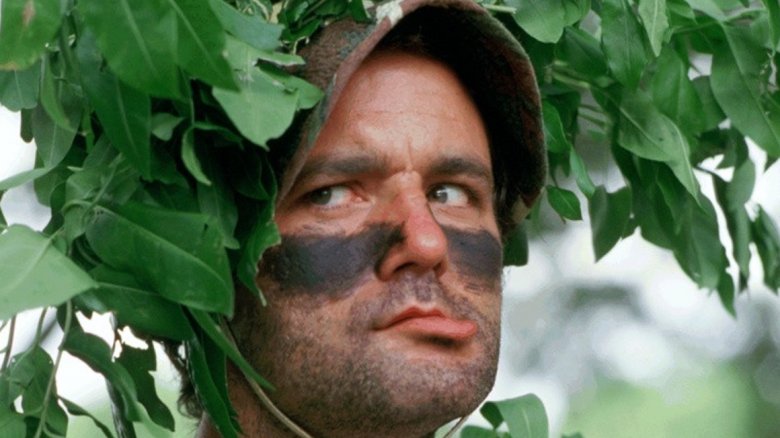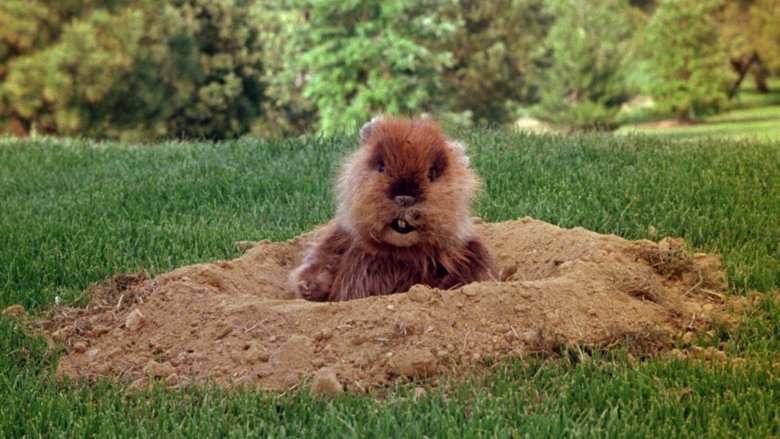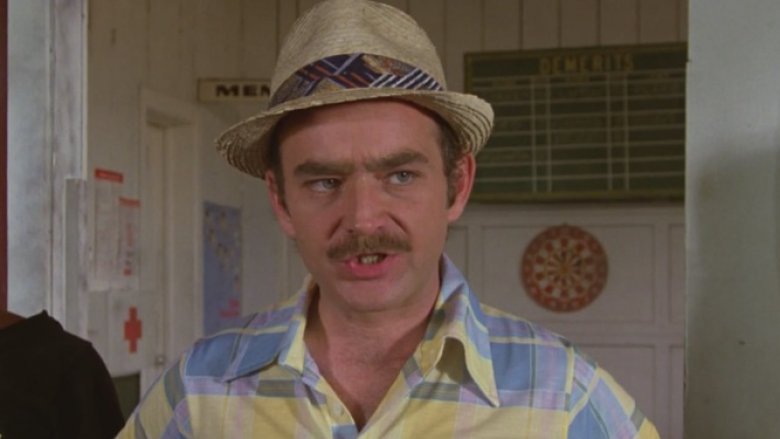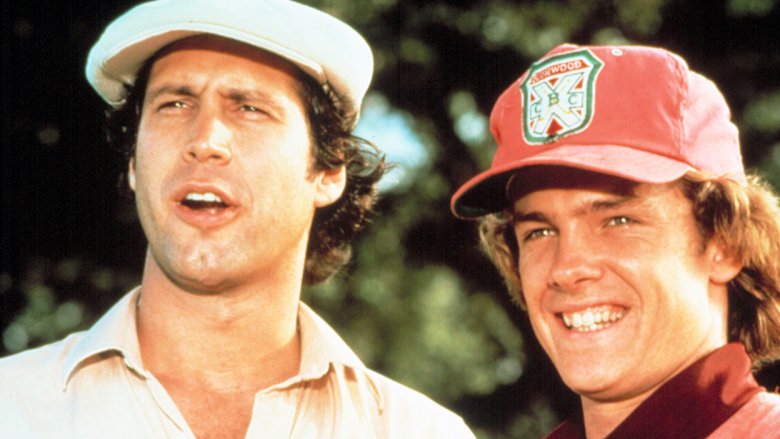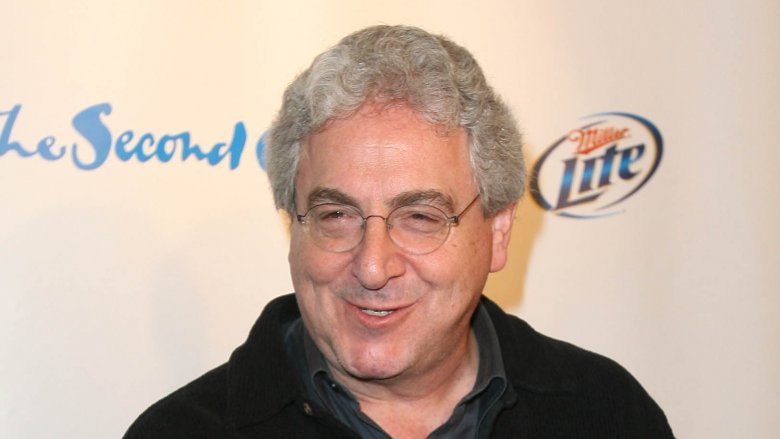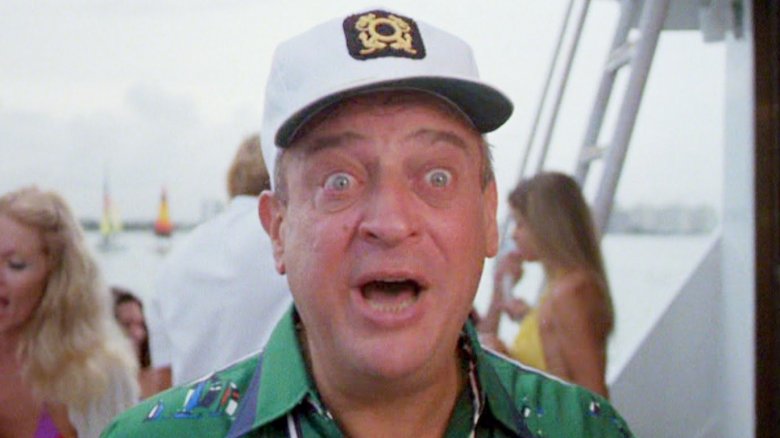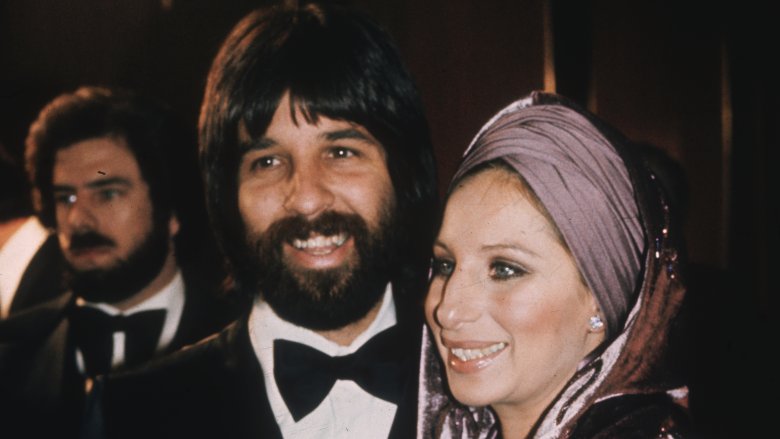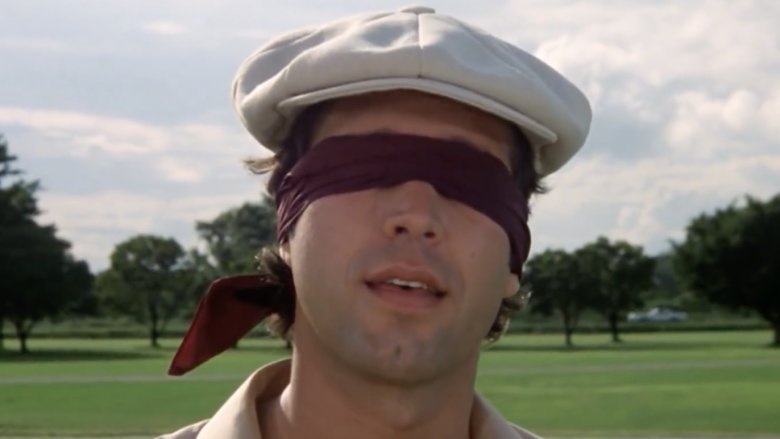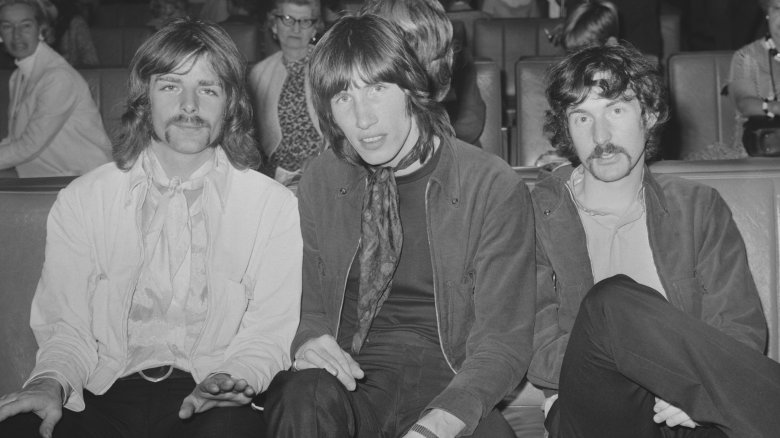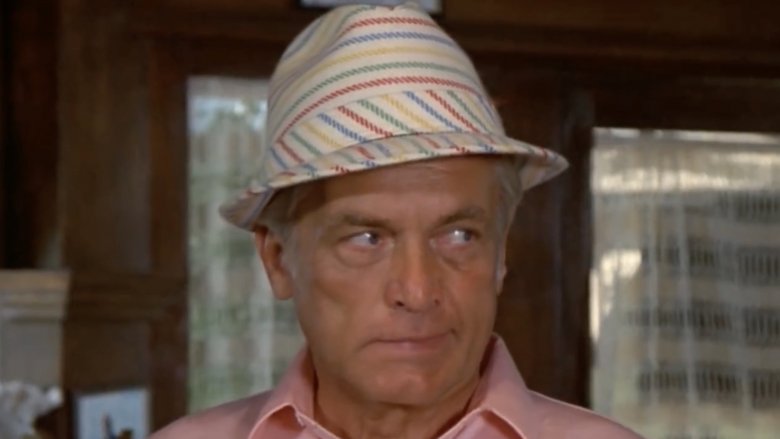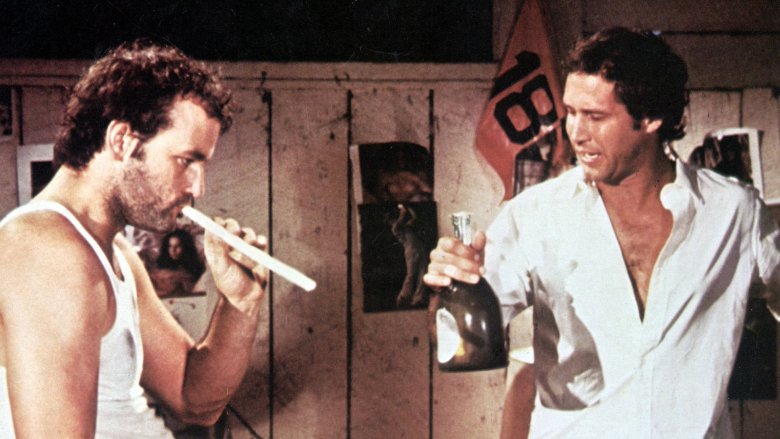The Untold Truth Of Caddyshack
Caddyshack is one of the best and most loved comedies of all time. The unassuming episodic movie set at a well-to-do country club also ranks among the best sports movies of all time, telling the many stories of a group of young caddies (led by Michael O'Keefe as scholarship-seeking Danny Noonan), uptight golfers (Ted Knight as Judge Smails), old-school party animals (Rodney Dangerfield as Al Czervik), likably smarmy rich guys (Chevy Chase as Ty Webb), and bonkers, gopher-and-golf-obsessed groundskeepers (Bill Murray in the career-making role of Carl Spackler). The film also gave pop culture some unforgettable moments, such as Murray's "Cinderella Story" fantasy monologue, an errant Baby Ruth in the country club pool that definitely doesn't look like candy, and a wily, dancing gopher.
Made by the team behind National Lampoon's Animal House, Caddyshack is the source of decades of Hollywood rumor, legend, and mythology. Here's a behind the scenes look at the 1980 classic — and the untold truth of Caddyshack.
It was born out of the rejection of two other, more bizarre movies
After National Lampoon's Animal House became a monster hit in 1978 — adjusted for inflation, it earned the equivalent of $555 million and made the Lampoon a viable and sought-after movie brand — the film's co-writers, Doug Kenney and Harold Ramis, had Hollywood at their feet. They could make pretty much any movie they wanted, and so, when it came time to explain their follow-up ideas to producers, they aimed high — and decidedly weird.
Kenney pitched an idea for a movie about Buddhism, which would also parody 1970s-style "New Age" religion and spirituality. Ramis wanted to make a dark, satirical comedy about the Illinois American Nazi Party, which in the late '70s had legally won the right to march through the predominantly Jewish Chicago suburb of Skokie, Illinois. Orion Pictures boss Mike Medavoy turned down both projects on the grounds that they were unworkable. Not long after, Kenney and Ramis threw another idea at Medavoy: a class satire that took place at a country club, based around the youthful experiences of their friend and collaborator (and real-life former caddie) Brian Doyle-Murray. That got them a green light.
The first draft was overstuffed
A lot of the golf course business (and silly anecdotal episodes) in Caddyshack is based on actual experiences. Co-writer and co-star Brian Doyle-Murray grew up in the Chicago area, and caddied at the elite Indian Hill Country Club in Winnetka, Illinois. Co-writer Doug Kenney somewhat based the main character, scholarship-hungry golf caddie Danny Noonan, on himself, although it was Doyle-Murray's older brother, Ed, who also worked as a caddie and won the Indian Hill's Click Evans Caddie Scholarship, exactly like Danny's big goal.
Also, like Doyle-Murray, Danny is part of a huge family, and he works for a caddie master named Lou (played by Doyle-Murray) who loves to gamble. Doyle-Murray based his portrayal of Lou on his own caddie master from back in the day — a guy who, as it turns out, was also named Lou. Even the notorious "Baby Ruth in the pool" bit is fact-based, although that happened at Doyle-Murray's high school, not his place of employment.
Ramis, Kenney, and Doyle-Murray spent three months writing the script and didn't just throw in their own experiences — they seemingly added every idea they could muster. The first draft of Caddyshack they turned in to producer Jon Peters came in at a whopping 200 pages. Considering that the rule of thumb for screenplays is that one page equals one minute of screen time, that would have been a three-hour, 20-minute movie... or about twice as long as the average comedy. Needless to say, they trimmed it down.
Caddyshack starring... Mickey Rourke?
The depth and breadth of comedic talent on display in Caddyshack gave the film one of the best all-star lineups in funny movie history. SNL veterans Chevy Chase and Bill Murray are in there, alongside the great Mary Tyler Moore Show veteran Ted Knight, irascible character actor (and Caddyshack co-writer) Brian Doyle-Murray, and beloved stand-up comedian Rodney Dangerfield. Even relative newcomer Michael O'Keefe, as caddie Danny Noonan, puts on a great display of comic chops. It's weird to think that Caddyshack could have starred anybody other than those guys, but it almost did.
For example, the role of Danny came down to O'Keefe and future Academy Award nominee Mickey Rourke, while co-writer and director Harold Ramis at first really wanted insult comic extraordinaire Don Rickles to portray crass golfer Al Czervik, up until he grew enchanted with Dangerfield after seeing him on The Tonight Show. Michelle Pfeiffer turned down the chance to play Lacey Underall because she didn't want to do nudity, while producer Jon Peters couldn't get the filmmakers on board with his choice for that role, Bo Derek.
The director had no idea what he was doing...
Caddyshack has a loose feeling to it, and that might because it was the first thing Harold Ramis had ever directed. "I walked on the set of Caddyshack and made a total fool of myself on the first setup," Ramis recounted in a letter published by his daughter Violet Ramis Stiel in her memoir, Ghostbuster's Daughter. When the assistant director asked Ramis where he wanted the camera placed, he didn't know what to say, and asked it to be pointed toward a bunch of golf course fairways. "The AD looked in the direction I was pointing and squinted. Apparently he noticed something I hadn't. 'So you want us to move the generator, the catering tent and all the trucks 'cause they'll be in the shot.'" After that, Ramis said, the shoot went fine because the crew had "the understanding that I knew nothing and should not be consulted on anything technical."
...and neither did one of the stars
Caddyshack also marked the feature film debut of Rodney Dangerfield — apart from a cameo in a movie a decade earlier — and the comic-turned-actor had no idea how movie production worked. "God bless Rodney, but he didn't understand how to make a movie," Michael O'Keefe (Danny) said in Josh Kurp's A Futile and Stupid Gesture. "Harold had to hold his hand through everything."
The first scene Dangerfield shot is the one where he makes fun of Judge Smails' hat in the pro shop. (The one that should come with "a free bowl of soup.") Dangerfield was supposed to enter into the shop from another room, but when Ramis called "action," nothing happened. Ramis asked Dangerfield if he was ready; he said he was, so Ramis called "action" once more. Same result. Finally, Ramis told Dangerfield, "Rodney, when I call action, you need to come in and do the scene." "Do my bit?" Rodney implored. "Yeah," Ramis confirmed. So from then on, for Dangerfield's scenes, Ramis wouldn't say action, but "do your bit" instead.
The sleazy actions of Mr. Barbra Streisand
Big-time movie producer Jon Peters also served as manager to Barbra Streisand (and he was her boyfriend). In 1978, Orion Pictures signed him to a three-year deal, reportedly in part because the studio wanted dibs on Streisand's future film projects. That's how he found himself in charge of Caddyshack, where he acted a bit gross on the set.
Cindy Morgan, cast as object of desire Lacey Underall, agreed to go topless for a sex scene. What she didn't think would be part of the job was Peters bringing in a photographer from Playboy to shoot a nude pictorial of Morgan to be used as a promotional spread for the film. Peters threatened to kill her budding career, so Morgan felt railroaded into posing, until director and co-writer Harold Ramis stood up to Peters and canceled the Playboy business.
Still, Peters had his revenge. "I didn't work for a long time after Caddyshack," Morgan later told The Neon Rewind. "Jon Peters broke my contract because I wouldn't shoot the nude scene for Playboy." Not only did Peters try to destroy her future prospects, Morgan was curiously not invited to the film's premiere in New York City. When Doug Kenney found out, he sent her a first-class plane ticket to make sure she attended. "I saw Jon Peters at the popcorn stand and walked up and said, 'Jon, what are you doing here?' and popcorn went flying everywhere."
The first cut was a bogey
At the end of principal photography in 1979, director/co-writer Harold Ramis and co-writer Doug Kenney hit the editing bay to assemble Caddyshack. The whole thing was a mess — scenes ran far too long, and there was way too much plot. There were also other scenes that weren't properly shot, with poor lighting and low production values. Nevertheless, Ramis and Kenney dutifully assembled a rough cut of the film that ran a staggering four hours in length. Producer Jon Peters hated the movie and grew furious with Kenney, who didn't want his boss taking creative control away from him at all. Nevertheless, all parties agreed to bring in a consultant to tell them how to fix Caddyshack, and that turned out to be an editor named David Breatherton. He helped the filmmakers craft a main narrative arc — Danny Noonan playing in the caddies' tournament and his budding relationship with a waitress — and recommending something to anchor the film and guide the audience through it. That solid ground, per Peters, was a recurring bit featuring a mechanical gopher (which cost the production $500,000.)
Pink Floyd was not 'alright' with doing the music
Harold Ramis and Doug Kenney had finished filming the movie and were in the middle of editing it when producer Jon Peters reminded them that they hadn't recorded any backing music yet, nor had they even asked anybody to do so. Ramis' dream candidate: Pink Floyd. The prog-rock band emphatically passed, so Peters called up a musician who'd worked with his girlfriend Barbra Streisand — the bearded duke of mellow gold, Kenny Loggins. The singer-songwriter headed to the Warner Bros. lot to watch a rough cut of the movie, and thought it was so good and so funny that he contributed four songs including the future Loggins anthem "I'm Alright." Inspired by the scene near the opening of Danny riding his bike, he wrote the song at his kitchen table just a few hours after he saw the film for the first time, and the tune went on to become a top 10 hit.
Coke was it
Cocaine fueled many sectors of the entertainment industry in the late '70s and early '80s, particularly rock n' roll, the National Lampoon while Caddyshack co-writer Doug Kenney worked there, and Saturday Night Live. According to accounts from cast members in Chris Nashataway's book Caddyshack: The Making of a Hollywood Cinderella Story, cocaine was very popular on the set of Caddyshack, too. Cast and crew snorted lines out in the open, and because the film was shot in the drug hotbed of Florida, it was "really good cocaine," according to cast member Hamilton Mitchell (Motormouth). Michael O'Keefe (Danny Noonan) said that "Cocaine was everywhere" during filming, explaining, "This was the '70s. No one thought anything was wrong about it. Those of us that did it got sucked into the whole bacchanalian rave of it, and believe me when I tell you we went as mad as any of the ancient Greeks." Peter Bekrot, who portrayed caddie Angie D'Annunzio, quipped that "the only person who didn't take drugs on the movie was Ted Knight."
How Caddyshack got two grown men to love each other once again
Despite lining up both Bill Murray and Chevy Chase, two of the biggest stars to ever come out of Saturday Night Live, the script somehow didn't include a scene where both comedy legends were on screen at the same time. During production, producer Jon Peters told Ramis to remedy that.
Perhaps that oversight had been made subconsciously and in the name of self-preservation, because when Caddyshack started filming, Murray and Chase hated each other, even coming to blows backstage at SNL. But orders are orders, and so Ramis, Doug Kenney, Brian Doyle-Murray (and Murray and Chase) crafted a scene — which doesn't have much bearing on the plot at all — in which golfer Ty Webb (Chase) visits groundskeeper Carl (Murray) in his weird little shed. Amazingly, at no point did Murray and Chase attack each other. In fact, making Caddyshack settled their feud. "We got over everything," Chase said in Chris Nashawaty's Caddyshack: The Making of a Hollywood Cinderella Story. "I have nothing but admiration and affection for Bill. He still can be a surly character, to say the least. But ultimately he's a good guy."
